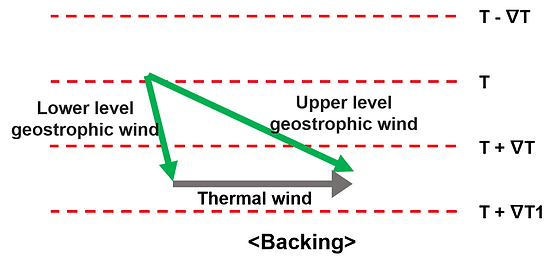
thermal wind
Advection is the horizontal transport or transfer of a quality such as heat and cold from one point to another. Advective transfers occur either in the oceans by currents of seawater or by large-scale movement in the atmosphere where humidity (atmospheric moisture) is another important property. In both cases a major example is the transport of cold air or water masses from the polar regions to lower latitudes.

Thermal wind is ideal wind generated by horizontal distribution of temperate.
If wind direction and speed change according to altitude, wind direction required by vector difference between two level(upper and lower) is parallel to two levels’direction and wind speed is in proportion to distance of isotherm.

backing is rotation of wind as altitude increase, wind direction rotate counterclockwise.
It indicates cold air inflow from North-West, so if backing exist, there is cold advection.

veering is rotation of wind as altitude increase, wind direction rotate clockwise.
It indicates warm air inflow from South, so if veering exist, there is warm advection.

On upper weather chart, we can estimate advection from form of isohypse and isotherm. Especially 850 hPa weather chart shows the atmosphere located at the level of about 1.5 km sea level height. At this level, friction is relatively small, so wind direction is parallel to isohypse. Therefore, if isohypse and isotherm is located perpendicularly or isohypse is dense, there may be strong advection.

